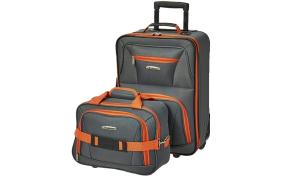Healthy eating doesn’t stop at what food you put in your body. What you have in your cupboards can contribute to overall health. One controversial question might center around your cooking and bake ware. Is non-stick cookware really toxic? Maybe you’ve heard that the chemical used to coat non-stick pans, perfluorooctanoic acid (PFOA), can contaminate your food and make you sick. Perhaps you avoid using non-stick pans for fear that you will harm your family. So what is the difference between non-stick and stainless steel? Should you really avoid non-stick cookware?

According to WebMD, non-stick pots and pans are safe as long as they are not overheated. If non-stick pans are overheated (above 550 degrees Fahrenheit), that coating breaks down and may release toxic gases, although it may not be until 660 degrees Fahrenheit that your family experiences symptoms related to the fumes, like chills, headache and fever. PFOA is found in many other products like microwave popcorn bags, carpet, shampoo and food packaging. In fact, the Food and Drug Administration tested non-stick pans to determine human exposure to PFOA and found that the process of making non-stick cookware actually drives off the PFOA, making the risk inconsequential. (via WebMD)
Videos by PopCulture.com
>> Read more: How to Break Toxic, Unhealthy Eating Patterns in Your Family
If non-stick pans aren’t dangerous, then why do people choose stainless steel? The answer depends on what you are cooking and what your end goal would be. Non-stick pans are great for cooking things that don’t require high heat like eggs, pancakes or French toast. If you are searing or sauteing, use stainless steel because it will charge with heat and retain it even when you add food. Most stainless steel pans are durable enough that they won’t need replaced, if handled properly. (via Stella Culinary)
If you choose non-stick over stainless steel, there are ways you can virtually eliminate any risk of toxic fumes. Do not preheat an empty pan. If it’s a cheap cookware set, it could reach temperatures to release toxic fumes in just two minutes if you preheat it empty. Be advised that you should avoid cooking on high with non-stick pans. Use some form of ventilation when you cook on a non-stick pan and consider investing in heavier non-stick pans. The lightweight pans will heat up more quickly so it is probably worth the investment.
>> Read more: 7 Staples All Kitchens Need

Alternatives to non-stick pans include cast iron, ceramic, glass and glazed clay. Cast iron cookware is durable and distributes heat more evenly, retaining the heat even after the stove top is turned off. Ceramic and glass cookware are nonreactive and won’t release chemicals into your food, even under high heat. Clay cookware isn’t quite as durable and you have to make sure you are taking care of it to make it last, but it holds heat and moisture well and also helps retain nutrient content in your food. Whatever you choose to use in the kitchen, keep in mind that the options are endless and proper care for your products is key to making sure everything is safe for your family. Click here to learn about knives and which ones you should be using!
>> Click here and read about the benefits of backyard composting!
Related Posts
-

SAN FRANCISCO, CALIFORNIA – NOVEMBER 04: Cans of Monster Energy Drink are displayed on a grocery store shelf on November 04, 2021 in San Francisco, California. Monster Beverage will report third quarter earnings today after the bell. Analysts anticipate the beverage company to report earnings of $1.39 billion.




